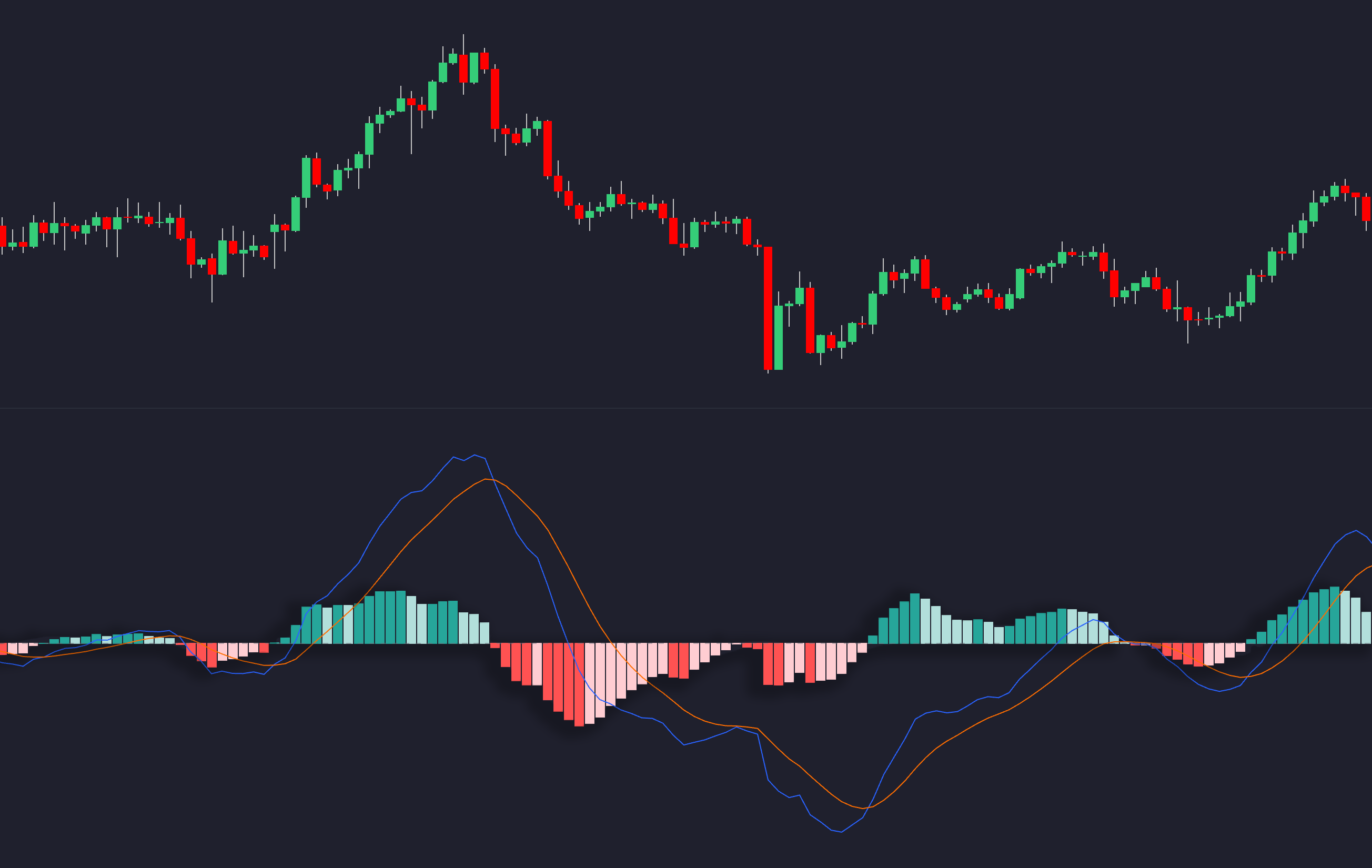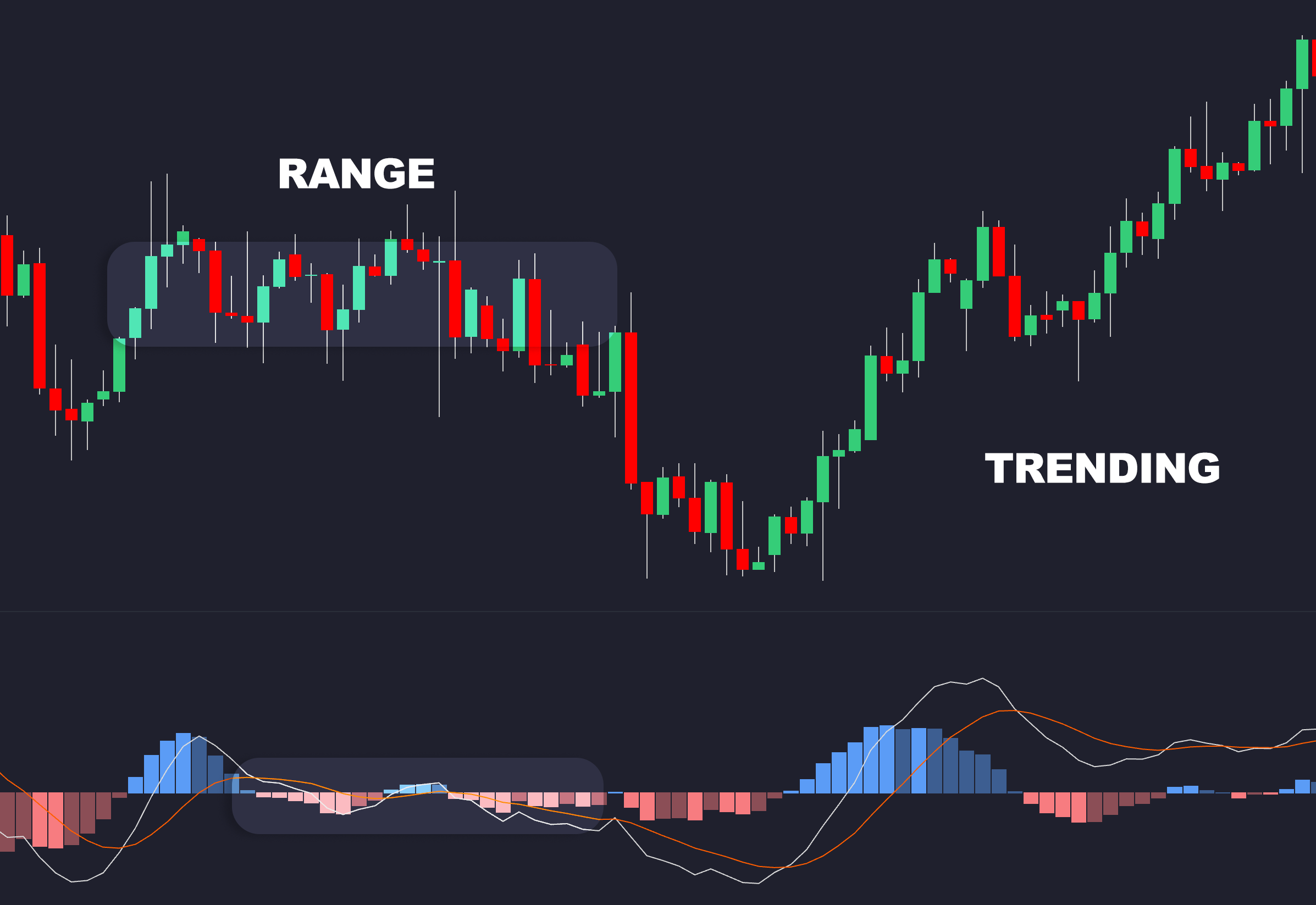Explore how MACD crossovers perform differently in trending and ranging markets, and learn strategies for optimizing trading signals.
MACD crossovers are powerful signals, but their effectiveness depends on market conditions. In trending markets, they work well for spotting momentum shifts and trend continuation, offering higher accuracy and profits. In ranging markets, frequent reversals lead to false signals, requiring adjustments like longer EMA settings or confirming tools such as RSI or Bollinger Bands.

Key Takeaways:
- Trending Markets: Higher success rates (70-80%), stronger profits (2-3% per trade), and lower false signals.
- Ranging Markets: Lower accuracy (40-50%), smaller profits (0.5-1%), and more noise.
- Optimization Tips: Use tools like volume analysis, RSI, and divergence detection to improve reliability.
Quick Comparison:
| Metric | Trending Markets | Ranging Markets |
|---|---|---|
| Signal Accuracy | 70-80% | 40-50% |
| Avg. Profit/Trade | 2-3% | 0.5-1% |
| False Signal Rate | 20-30% | 50-60% |
| Max Drawdown | 10-15% | 20-25% |
Tailor your MACD strategy to the market phase for better results.
This Trend Indicator ALSO Filters Out Ranging Markets
MACD Signals in Trending Markets
When markets show a clear upward or downward direction, MACD crossovers become a go-to signal for traders.
Signal Quality During Trends
In trending markets, the MACD often stays consistently above or below the zero line, depending on the trend's direction. The histogram helps traders spot momentum changes early, acting as a warning for when a trend might lose steam.
Trade Entry and Exit Methods
These methods take the basic crossover signals and refine them with trend-specific filters to improve accuracy.
Here are some common MACD-based entry strategies used by experienced traders:
| Signal Type | Entry Criteria |
|---|---|
| Trend Initiation | MACD crosses the signal line near the zero line |
| Pullback Entry | MACD crosses in the trend direction after a retracement |
| Trend Continuation | MACD crosses after consolidation with a strong histogram |
Trending market performance data:
| Market Condition | Success Rate | Average Profit |
|---|---|---|
| Strong Uptrend | 72% | 2.8% |
| Strong Downtrend | 68% | 2.5% |
To get the most out of MACD crossovers in trending markets, focus on aligning momentum with the trend. When the MACD line's slope matches the market's direction and remains on the proper side of the zero line, signals tend to be more dependable[4].
Many seasoned traders also combine MACD with other trend-confirmation tools. Adding trend-following indicators to the mix has been shown to boost trading results by 22%[5]. This layered approach strengthens the overall strategy while preserving MACD's core advantages.
Although these strategies shine in trending markets, MACD crossovers behave differently in ranging conditions—a topic we'll explore next.
MACD Signals in Ranging Markets
In markets that move sideways, MACD crossovers behave differently than in trending environments. The frequent shifts between support and resistance levels bring about three main challenges:

- Price movements are limited, keeping the MACD and signal lines close together.
- Momentum is weak, making it hard to sustain directional moves.
- Frequent reversals between support and resistance levels create noise.
Common Problems in Ranges
False signals are far more common in ranging markets, occurring 60-70% of the time compared to 30-40% in trending markets [2][4][3]. To address this, traders often make adjustments such as:
- Changing the default MACD settings from 12,26,9 to 21,55,9 to reduce noise [3].
- Requiring a zero-line crossover before acting to improve signal reliability.
- Monitoring volume patterns to confirm potential breakouts.
Reducing False Signals
Pairing the MACD with tools designed for range-bound conditions can improve accuracy. Here are some popular techniques:
- Bollinger Bands: Identify the upper and lower boundaries of the range.
- RSI: Spot overbought or oversold conditions.
- Volume Patterns: Confirm whether a breakout is likely.
Some advanced features, like the Oscillator Matrix toolkit, take this a step further by integrating MACD with real-time divergence detection. This approach helps traders spot breakout opportunities while filtering out weaker signals within the range [3].
Trending vs. Ranging Performance
The gap in performance between trending and ranging markets becomes clear when looking at the numbers. A 2021 analysis of S&P 500 data highlighted major differences in reliability and outcomes [1].
Performance Metrics Table
| Metric | Trending Markets | Ranging Markets | Key Insights |
|---|---|---|---|
| Signal Accuracy | 70-80% | 40-50% | Trends lead to higher accuracy and profits |
| False Signal Rate | 20-30% | 50-60% | Ranging markets generate over twice as many false signals |
| Avg. Profit/Trade | 2-3% | 0.5-1% | Trending markets yield 3-4x more profit per trade |
| Max Drawdown | 10-15% | 20-25% | Ranges come with significantly higher risk |
| Risk-Adjusted Return | 1.5-2.0 | 0.5-1.0 | Trends deliver better risk-reward ratios |
These numbers explain why traders often adjust their strategies based on market conditions. In trending markets, they frequently rely on MACD crossovers for entries, as covered in the pullback entry methods from Section 2. For ranging markets, the focus shifts to divergence patterns, with added confirmation from other indicators.
"MACD crossovers can be powerful standalone signals in trends but require additional confirmation in ranges" - Technical Analysis of Stocks & Commodities [1]
This emphasizes the importance of identifying the market phase before applying MACD strategies. Traders who combine MACD with tools like ADX for trend confirmation tend to achieve better results than those using the same approach across all conditions.
Advanced MACD Analysis Methods
Traders can enhance the effectiveness of the MACD by using additional tools and tailored strategies. Pairing the MACD with indicators such as the RSI often improves the accuracy of trading signals.
Signal Confirmation Tools
The Oscillator Matrix toolkit offers real-time divergence detection, which complements MACD analysis. Using these methods alongside MACD crossovers can provide stronger and more reliable signals:
| Confirmation Method | How It Helps |
|---|---|
| Volume Analysis | Tracks market participation during crossovers |
| RSI Confluence | Confirms overbought or oversold levels |
| Multiple Timeframes | Aligns signals with broader market trends |
The Price Action Concepts (PAC) toolkit is another useful resource. It highlights volumetric order blocks that correspond with MACD signals, offering additional insight into potential reversals. Consistently applying these methods is more effective than relying on random combinations.
Market-Specific Tactics
Tailor your confirmation methods to the current market environment:
Trending Markets:
- Watch for histogram expansion to confirm trend strength.
- Use the Signals & Overlays toolkit to pinpoint key levels and manage trades.
Ranging Markets:
- Apply the Signals & Overlays toolkit to identify the boundaries of trading ranges.
For further optimization, the AI Backtesting platform can help fine-tune strategies across different assets and timeframes. This allows traders to test and refine their approach for better results.
Key Takeaways
The performance of MACD crossovers varies significantly between trending and ranging markets, with trending markets showing success rates up to 2-3 times higher than ranging ones[3]. This difference calls for tailored strategies:
Trending Market Performance
MACD crossovers work best in trending markets, especially when:
- The signal line crossover aligns with the current trend.
- The MACD histogram indicates increasing momentum.
- Crossovers occur alongside rising trading volume.
Ranging Market Adjustments
In sideways or non-trending markets, traders should fine-tune their approach by:
- Using longer EMAs (e.g., 21, 55, 9) for clearer signals.
- Confirming signals with RSI at key support or resistance levels.
- Incorporating multiple timeframe analysis for better context.
Risk management essentials: Adjust position sizes based on volatility and use MACD-confirmed stop levels to minimize losses[6].
By integrating MACD with features like the Oscillator Matrix toolkit, traders can enhance their analysis with real-time divergence alerts. Additionally, the Price Action Concepts toolkit helps identify critical support and resistance levels, providing a stronger foundation for decision-making.
This strategy aligns with the recommendations discussed earlier, emphasizing the importance of trend-focused setups in directional markets.
FAQs
What is the most accurate MACD setting?
The standard MACD settings (12, 26, 9) are popular, but the best setup varies based on market conditions and timeframes. Here's a breakdown of what works in different scenarios:
Trending Markets: Use 19, 39, 9 for clearer signals during strong trends.
Ranging Markets: Try 21, 55, 9 for better accuracy in identifying reversals within ranges.
These adjustments can improve signal reliability:
- Trending Markets: Longer periods help filter out noise, making signals clearer during strong directional movements.
- Ranging Markets: Tweaked settings are better at spotting reversals and provide more precise signals compared to the standard configuration [3].
The Oscillator Matrix toolkit provides dynamic MACD analysis, while the AI Backtesting platform helps test parameters using historical data. According to a Forex Factory study, standard MACD settings show a 62% success rate in trends, but optimized configurations perform better in range-bound markets [3]. These insights align with the market-specific strategies discussed earlier.
Adaptive MACD: An Enhanced Approach
The Adaptive MACD builds upon the traditional MACD indicator by automatically adjusting its parameters based on current market volatility and trends. This dynamic approach helps reduce lag and improves signal accuracy in both trending and ranging markets.
By incorporating adaptive smoothing techniques, the Adaptive MACD provides more responsive signals that can better capture rapid market shifts. This enhanced version minimizes false signals and optimizes entry and exit points, making it a valuable asset for traders seeking a refined analysis tool.
Discover more about this innovative indicator on the LuxAlgo Library and explore its detailed features on TradingView here.

This improved version further enhances signal processing and reduces noise, making it an ideal tool for both short-term and long-term analysis.



